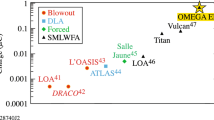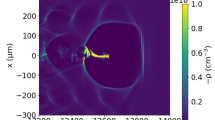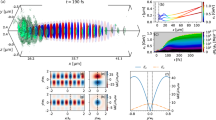Abstract
Interest in the development of laser-driven linacs has been stimu-lated recently by the advent of the high-power lasers. The use of a laser to accelerate charged particles was first proposed by K. Shimoda in 19621. He noticed that high values of acceleration per metre (acceleration gradient) could be obtained with an intense electric field in the output of a high-power laser. The inverse Smith–Purcell (ISP) effect proposed by us2 is a candidate for laser-driven linacs with a metallic grating as an interaction circuit. In 1953 Smith and Purcell demonstrated that light is emitted when a high-voltage electron beam moves parallel and close to a metallic optical diffraction grating in a direction perpendicular to the grating rulings3. The dispersion relationship is a synchronous condition between the electrons and the wave on the grating. Therefore, the inverse Smith-Purcell effect (ISP), or the extended interaction between electrons and an incident light wave should occur when the same relation is satisfied between the electrons and the incident wave (Fig. 1)2. Lawson pointed out4 that this effect would fail to accelerate relativistic particles. This difficulty was solved by Palmer5, who showed that acceleration is possible either if the particles travel skew to the grating lines, or if the radiation is falling at a skew angle onto the grating. Several authors have described possibilities for producing a grating linac (ISP effect) with accelerating field of a few GeV m−1 in the infrared or optical wave region6. Here we report the first observational evidence for this effect using a submillimetre-wave laser as a driving source. The experimental results give good agreement with theoretical predictions.
This is a preview of subscription content, access via your institution
Access options
Subscribe to this journal
Receive 51 print issues and online access
$199.00 per year
only $3.90 per issue
Buy this article
- Purchase on Springer Link
- Instant access to full article PDF
Prices may be subject to local taxes which are calculated during checkout
Similar content being viewed by others
References
1. Shimoda, K. Appl Opt. 1, 33–35 (1962). 2. Mizuno, K., Ono, S. & Shimoe, O. Nature 253, 184–185 (1975). "< Smith. S J & Purcell. F M PJiw Rer 92. 106Q < ]Q^} 4. Lawson, J. D. Rutherford Lab. Rep. Laser Accelerators RL–75–043 (1975). 5. Palmer, R. B. Particle Accel. 11, 81–90 (1980). 6. Cannell, P. J. (ed.) AIP Conf. Proc. no. 91 (AIP, New York, 1982). 7. Mizuno, K. & Ono, S. in Infrared and Millimeter Waves Vol. 1 (ed. Button, K. J.) (Academic, New York, 1979).
Author information
Authors and Affiliations
Rights and permissions
About this article
Cite this article
Mizuno, K., Pae, J., Nozokido, T. et al. Experimental evidence of the inverse Smith–Purcell effect. Nature 328, 45–47 (1987). https://doi.org/10.1038/328045a0
Received:
Accepted:
Issue Date:
DOI: https://doi.org/10.1038/328045a0
This article is cited by
-
Weak measurements and quantum-to-classical transitions in free electron–photon interactions
Light: Science & Applications (2023)
-
Coherent nanophotonic electron accelerator
Nature (2023)
-
Efficiently accelerated free electrons by metallic laser accelerator
Nature Communications (2023)
-
Resonant phase-matching between a light wave and a free-electron wavefunction
Nature Physics (2020)
-
Direct acceleration of electrons by a CO2 laser in a curved plasma waveguide
Scientific Reports (2016)
Comments
By submitting a comment you agree to abide by our Terms and Community Guidelines. If you find something abusive or that does not comply with our terms or guidelines please flag it as inappropriate.



